Commodore 65
The Commodore 65 (also known as the C64DX) is a prototype computer created at Commodore Business Machines in 1990-1991. It is an improved version of the Commodore 64, and it was meant to be backwards-compatible with the older computer, while still providing a number of advanced features close to those of the Amiga.
_(balance).jpg) | |
| Type | Personal computer |
|---|---|
| Release date | N/A |
| Discontinued | N/A |
| Operating system | Commodore BASIC 10.0 |
| CPU | CSG 4510 R3 @ 3.54 MHz |
| Memory | 128 kB (8 MB maximum) |
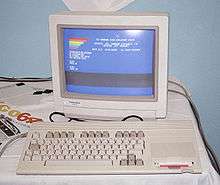

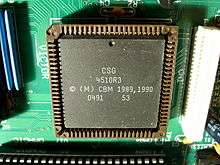
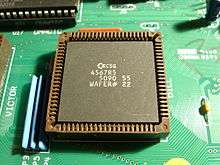

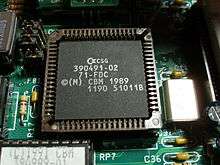
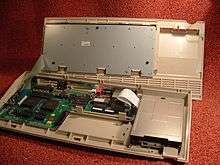

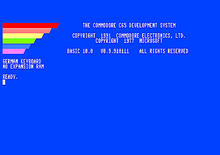
History
In September 1989 Compute!'s Gazette noted that "Sales of the 64 have diminished rapidly, Nintendo has eaten big holes in the market, and the life of the old warhorse computer should somehow be extended." Noting that Apple had developed the IIGS to extend the life of its Apple II series, the magazine asked "Will Commodore take the same tack?", then continued:[1]
The latest rumor says Yes. We've heard reports from several sources of a new machine from Commodore—A 64GS, if you will. This machine is reportedly driven by a GE802, a version of the 65816 microprocessor (which is a 16-bit version of the 6502 chip), and runs at 4 MHz (by comparison, the 64 runs at 1 MHz; the Amiga, at slightly over 7 MHz). It comes with 128K of RAM and is expandable to one megabyte. Fully expanded, it supports 256 colors. Maximum resolution is a stunning 640 X 400 pixels. We've also heard that it has a 64 mode so that 64 owners can purchase a much more powerful machine and still use their software library. The 64GS reportedly comes with a built-in 3 1/2-inch disk drive and will support the 1581. But, our sources say, it does not support the 1541 or the 1571 drive (uh, excuse me, please pass the bologna). All we've heard about sound in the new machine is that it's "enhanced" and features stereo output. The final tidbit is that the 64GS will retail in the $300-$350 range when it debuts in November.
The Gazette added, "Our sources also report that there is a great deal of infighting at Commodore as to whether the machine should be released. The sales staff wants to get the machine out the door, while the naysaying engineers have dubbed it 'son of Plus/4.'"[1] While the next issue reported that "the latest rumor is that such a machine will never see the light of day",[2] Fred Bowen and others at Commodore in 1990–1991 developed the Commodore 65 (C65) as a successor to the C64. In the end of 1990 the decision to create the C65 was taken.[3] The project was cancelled later on.
When Commodore International was liquidated in 1994, a number of prototypes were sold on the open market, and thus a few people actually own a Commodore 65. Estimates as to the actual number of machines found on the open market range from 50 to 2000 units.[4] As the C65 project was cancelled, the final 8-bit offering from CBM remained the triple-mode, 1–2 MHz, 128 kB (expandable), C64-compatible Commodore 128 of 1985.
Technical specifications
- The CPU named CSG 4510 R3 is a custom CSG[5] 65CE02 (a MOS 6502 derivative), combined with two MOS 6526 complex interface adapters (CIAs), a UART serial interface, and a memory mapper to allow for an addressable space of 1MB[6]
- 3.54 MHz clock frequency (the C64 runs at 1 MHz)
- A new VIC-III graphics chip named CSG 4567 R5, capable of producing 256 colors from a palette of 4096 colors; available modes include 320×200×256 (8), 640×200×16 (4), 640×400×16 (4), 1280×200×4 (2), and 1280×400×4(2) ( X×Y×color depth, i.e. number of colors (bit planes) )
- Two CSG 8580R5 SID sound chips producing stereo sound (the C64 has one SID)
- Separate control (left / right) for volume, filter and modulation
- 128 kB RAM, expandable with up to 1 MB[6] using a RAM expansion port similar to that of the Commodore Amiga 500
- 128 kB ROM
- Heavily improved BASIC: Commodore BASIC 10.0 (the C64 has the relatively feature-weak BASIC 2.0, which was almost 10 years old by this time.)
- One internal 3½" DSDD floppy disk drive
- Keyboard with 77 keys and an inverted T directional cursor block
Different views
Ports
Left side:
Back:
- Expansion port 50-pin[6]
- CBM-488 bus using a 6-pin DIN for 1541/1571/1581[6]
- User port: parallel 24-pin (without 9V AC)[6]
- Stereo 2× RCA connector[7] for left and right channel[6]
- RGBA video DE9F[6][8]
- RF video[6]
- Composite video 8-pin DIN[6]
- External fast floppy drive port - mini-DIN-8[6]
Bottom flap:
- RAM expansion[6]
Dimensions: ≈46 cm wide, 20 cm deep, 5.1 cm high[6]
Chipset names
The custom chips of the C65 were not meant to have names like the custom chips in the Amiga. Although there are names printed near the chip sockets on various revisions of the circuit board, they were not intended as names for the chips. According to former Commodore engineer Bill Gardei, "The Legend on the PCB was to let others in the organization know [whom] to go to for advice on the chips. We did have an issue with that. But that wasn't the name of the chip at the time. The 4567 was always called the VIC-3. I can see why others outside of Commodore made the connection. But again—no—we never called these chips 'Victor' or 'Bill'."[9]
The custom chips for the C65 are:
- CSG 4510: processor (commonly called "Victor" after Victor Andrade)
- CSG 4567: VIC-III graphics processor (commonly called "Bill" after Bill Gardei)
- CSG 4151: DMAgic DMA controller (designed by Paul Lassa)
- F011C: FDC (floppy disk controller, also designed by Bill Gardei)
The C65 also contains one or two programmable logic arrays depending on the version:
- ELMER: PAL16L8 (C65 versions 1.1, 2A, 2B), PAL20L8 (C65 versions 3-5)
- IGOR: PAL16L8 (C65 version 2B only)
Graphics subsystem
The main memory of the C65 is shared between the graphics subsystem and the CPU. The memory clock runs at almost twice the speed of the C64. To further increase the bandwidth of the graphics subsystem, the memory is divided into 2× 8-bit wide banks of 64 Kbyte which can be accessed by the CSG-4567 simultaneously. This provides an effective video-DMA bandwidth of 7.2 Mbytes/second which is the same specification as the original 16-bit Commodore Amiga chipset (OCS/ECS). The CPU can use up to half the available bandwidth, since it can only access a single 8-bit bank at a time. In higher demanding video modes, the CPU is slowed down due to increased cycle stealing from the video controller.
Enhanced VIC-II modes
In addition to having all of the C64 video modes, the CSG-4567 also supports several new character attributes such as "blink" or "bold" and can display any of the new or old video modes in 80 column or 640 horizontal pixel format, as well as the older 40 column 320 pixel format [6]. These enhanced "VIC-II" modes take up to 16 Kbyte of system RAM. The sprite capabilities in all VIC modes are equivalent to the C64.
Bitplane modes
A new "bitplane" video mode was added to allow the displaying of true bitplane type video, with-up to eight bitplanes in 320 pixel mode and up to four in 640 pixel mode. The CSG-4567 can also time-multiplex the bitplanes to give a true four-color 1280 pixel picture. Vertical resolution is maintained at 200 lines as standard, but can be doubled to 400 with interlace [6]. The VIC-III bitplane modes take up to 64 Kbyte of system RAM in non-interlaced or 128Kbyte RAM in interlaced (400 line) modes. Since the C65 is equipped with only 128Kbyte in its basic configuration, these modes would consume the entire RAM, and are therefore only useful in a RAM expanded system. On a basic system, it would probably have made more sense to write software which uses less demanding resolutions with fewer bitplanes - partly because this would consume less of the confined RAM space, but also because more bitplanes would demand a higher video DMA bandwidth and consequently slow down the CPU as a result.
DAT and Blitter
The bitplanes on the C65 are organized in a less straightforward manner than e.g. on the Commodore Amiga, which organizes the bitplanes as straight rows off pixels: On the C65, the bytes within the bitplanes are organized as 25 rows of 40 or 80 stacks of 8 sequential bytes, similar to the original 320×200 VIC modes. Because this makes it harder to derive individual byte and pixel addresses from their position in the XY coordinate frame, the C65 provides a conversion mechanism in hardware called Display Address Translator (DAT).
Further aid to the programmer comes in the form of a bit-blitter, which supports
- Copy (up,down,invert), Fill, Swap, Mix(boolean Minterms) Hold, Modulus (window), Interrupt, and Resume modes
- Block operations from 1 byte to 64 Kbytes
DOS
In contrast to previous 8-bit computers from Commodore, the C65 has a complete DOS through which the built-in 3.5" floppy disk drive can be controlled. Disks used by the C65 have a storage capacity of 880kB and the drive is compatible with C1581. Since this format was uncommon for the former C64 owners, the C65 retains the serial IEC port for external Commodore disk drives. It's possible to use a 1541, 1571, 1581, or other similar model.
The DOS itself is based on the Commodore PET IEEE 8250 drive DOS. Since it can only deal with two floppy disk drives, including the internal, only one external drive may be connected to the internal floppy disk controller. Like earlier systems, up to 4 drives can be daisy-chained on the IEC port.
Interfaces
The C65 includes the same ports of the C64. In addition, there is a DMA port for memory expansion. The latter is attached just like on the Amiga 500 via a flap in the bottom of the board.[10] The built-in floppy disk drive is connected in parallel, serial Commodore drives can be connected via the usual IEC port. A plug for a genlock was also provided. Only the port for the C64 datasette is no longer available, and the user port missing—like the Aldi C64—the 9 volt AC line. The expansion port differs significantly from all prior C64 variants and rather resembles that of C16.
Sales
In December 2009, a working C65 on the online auction site eBay achieved a sales price of €6060.[11][12]
A computer with missing parts was in October 2011 sold for about US$20,100.
In April 2013 an eBay auction reached a price of 17,827 EUR.[13]
In February 2015 an eBay auction closed at 20,050 EUR.[14]
An eBay auction in November 2016 reached 15,605 EUR.[15]
On September 7, 2017 a non-functional C65 missing a VicIII chip, sold via eBay auction for US$18,350.00.[16]
On October 8, 2017 a user at lemon64.com notified members their intent to sell a fully functioning C65 with the asking price of US$27,000.[17]
On November 2017, a C65 prototype with RAM expansion board were sold for 81,450 €.[18]
On December 30, 2017, a non-functioning C65 motherboard without most of the chips was sold on EBay for $790 US.[19]
On May 18, 2019, a functional C65 was sold on eBay at 20,550 Euro.[20]
Legacy
In April 22, 2015 the Museum of Electronic Games & Art (MEGA)[21] announced a recreation of this computer featuring similar specifications and technologies. Also backwards compatible with the Commodore 64,[22] the Mega 65[23][24] will feature a Commodore 65 compatible hardware[22] recreated in FPGA and will be compatible with newer technologies such as HDMI.[25] MEGA initially aimed to release their recreation of the Commodore 65 computer for the third quarter of 2016,[22] as of June 2020, the pre-release dev-kit has been released. Check it out at https://mega65.org
References
- Elko, Lance (September 1989). "Editor's Notes". Compute's Gazette. p. 4. Retrieved 4 March 2015.
- Elko, Lance (October 1989). "Editor's Notes". Compute's Gazette. p. 2. Retrieved 4 March 2015.
- "OLD-COMPUTERS.COM museum ~ Commodore C65". old-computers.com. Archived from the original on 2010-10-10. Retrieved 2013-06-20.
- "Secret Weapons of Commodore: The Commodore 65". floodgap.com. 2007-07-01. Retrieved 2013-02-26.
- Commodore Semiconductor Group, previously known as MOS Technology, Inc
- "C64DX System specification". zimmers.net. 2009-08-18. Retrieved 2013-06-21.
- "c65_html_1410c60e.gif". retrocommodore.com. 2012-12-16. Archived from the original on 2013-06-24. Retrieved 2013-06-21.
- "commodore.ca/gallery/hardware/c65.jpg". commodore.ca. 2011-03-29. Retrieved 2013-06-21.
- "The Story Behind 'Bill' and 'Victor'". collectorcomputers.com. 2013-11-16. Archived from the original on 2015-06-10. Retrieved 2013-11-16.
- "C65 open". commons.wikimedia.org. 1997. Retrieved 2013-06-20.
- "C65-Auktion auf eBay". cgi.ebay.at. Retrieved 2010-01-03. (dead link)
- "C65-Auktion auf eBay". img5.imagebanana.com. 2012-11-10. Archived from the original on 2016-03-04. Retrieved 2010-01-04.
- "Sehr seltener Prototyp Commodore C65 aka C64DX aka C90". ebay.de. 2013-04-14. Retrieved 2013-04-18.
- "Ultra rare Commodore 65 / C65 / DX64 prototype, working, serial #22". ebay.fr. 2015-02-15. Retrieved 2015-02-15.
- "Commodore 65 prototype, ULTRA RARE! a.k.a. C65 / DX64 - clean and working!". ebay.de. 2016-11-06. Retrieved 2016-11-06.
- "Commodore 65 Computer - The Holy Grail of Commodore Collecting". ebay.com. 2017-09-08. Retrieved 2017-09-08.
- "FS: Working Commodore 65 / C64DX Prototype". lemon64.com. 2017-10-08. Retrieved 2017-10-08.
- "ULTRA RARE Commodore 65 + RAM-Espansione/c65/dx64/c90 Prototype, working!". eBay. 2017-11-08. Retrieved 2017-11-09.
- "Commodore C65 64DX Prototype Motherboard Logic Board 65". eBay. 2017-12-30. Retrieved 2017-12-30.
- "Ultra rare Commodore 65". ebay.de. 2019-05-13. Retrieved 2019-05-13.
- "MEGA | MEGA - Museum of Electronic Games & Art". www.m-e-g-a.org. Retrieved 2015-10-06.
- "MEGA65 Computer". mega65.org. Retrieved 2015-10-06.
- "Introducing the MEGA65 (8-bit) computer | MEGA - Museum of Electronic Games & Art". www.m-e-g-a.org. Retrieved 2015-10-06.
- "MEGA 65: Commodore 65 remake gets a physical release • /r/c64". reddit. Retrieved 2015-10-06.
- "Making a C64/C65 compatible computer in an FPGA". c65gs.blogspot.com. Retrieved 2015-10-06.
Further reading
- On the Edge: The Spectacular Rise and Fall of Commodore (2005), Variant Press. ISBN 0-9738649-0-7.
External links
| Wikimedia Commons has media related to Commodore 65. |
- Hi65: a high-level Commodore 65 emulator
- C65 page at 'The Secret Weapons of Commodore' website By Cameron Kaiser and The Commodore Knowledge Base
- FTP directory for the C65 at ftp.zimmers.net
- Andre Kaesmacher's C64DX Development Site
- C64DX System Specification document
- C65 System ROMs and Utility Software
- Commodore 65: Like The C64, But It's One Louder
- old-computers.com: LD-COMPUTERS.COM museum ~ Commodore C65, article on C65
- 8-Bit-Nirvana: Commodore 65
- heimcomputer.de: Commodore C65 Prototyp, German C65-site with many photos and info
- toxic-waste.de: Commodore C65 Information Page by TXW
- cbmmuseum.kuto.de: CCOM - Commodore 65